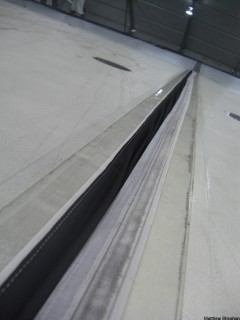In refining the wing sailed beast, slots have been on the mind of the design team
Well, well, well. A little stroll under the outer hulls of USA-17 the other day revealed a couple of slender details that have been the subject of recent controversy – slots.
With one just a few metres back from the bow and the other around midships, it’s not the ‘U’ shaped slots themselves that have caused the controversy but what can be ejected through them.
There’s nothing new in the concept of reducing surface friction by modifying the water with additives, several of the world’s navies have spent plenty of time looking at this. But to employ such techniques aboard a racing yacht is rare, largely as the Racing Rules of Sailing specifically prohibit such techniques.
But some time back in the build up to this Cup the rules for the event were modified when RRS49 to 54 were deleted, in effect permitting friction reducing techniques. The topic has been a hot one and the subject of plenty of disagreement between the two teams.
The recent Jury hearing just before the start of the event addressed this subject for which rule number 24 in the Sailing Instructions reads:
‘TRASH DISPOSAL AND ENVIROMENTAL PROTECTION
Boats shall not put trash in the water, or fail to fully recover anything (other than discharged water ballast) intentionally left by the boat in the water. A boat’s Chase Boats shall use reasonable efforts to recover any trash or other item left in the water from the boat.’
But what is trash? How would you prove that the device had been used and could you be sure that if something had been washed through the slots that it was anything other than harmless? BMW Oracle has stated on several occasions that whatever ‘it’ is, ‘it is green.’
In the potential issues that might be ‘taken to the room’, this one still lurks on the list.

One slot issue that isn’t controversial though, is the new addition to USA-17’s wing. Neoprene seals between each of the flaps have been fitted to prevent pressure leaking through the gaps. A neat detail and a similar technique to that used on aircraft, especially gliders, in order to stop the pressure leaking through the gap around the ailerons.




